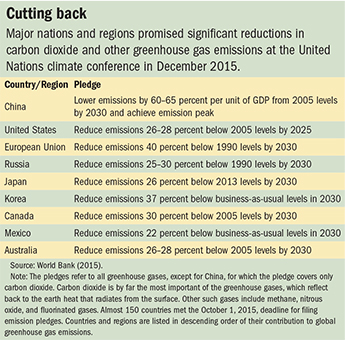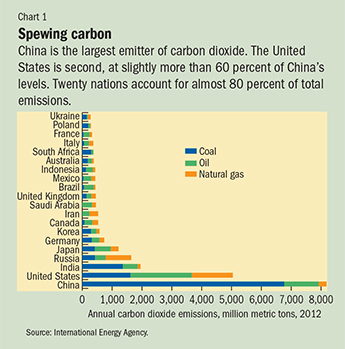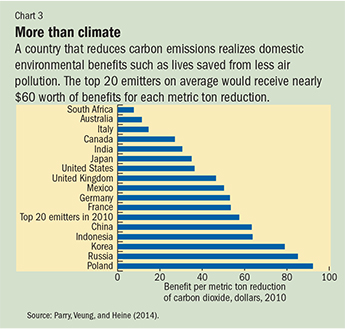The Right Price
Finance & Development, December 2015, Vol. 52, No. 4

Raising the cost of fossil fuels to reduce greenhouse gas emissions presents policymakers with practical, but manageable, issues
Unless steps are taken to reduce greenhouse gas emissions, global temperatures are projected to rise by about 3 to 4 degrees Celsius above preindustrial levels by 2100, with risks of more severe warming and climate instability. Both advanced and developing countries are pledging to reduce emissions in what are called Intended Nationally Determined Contributions, at the December 2015 United Nations climate conference in Paris (see table). If fulfilled, these pledges would significantly slow global warming, though probably not by enough to contain projected warming to 2 degrees Celsius, which is the official target of the international community.

The key practical challenge facing policymakers is how to fulfill these pledges, preferably with policies that do not overburden the economy and that deal with such sensitive issues as the strain higher energy prices place on vulnerable households and firms. Carbon dioxide is by far the most important source of atmospheric greenhouse gases, which essentially trap the earth’s heat and cause warming of the planet. Putting a price on emitting carbon dioxide from burning fossil fuels should be at the center of any policies and, because of domestic environmental benefits, may actually be in a country’s national interest regardless of what other countries do.
Global carbon dioxide emissions from fuel combustion are slightly more than 30 billion metric tons a year, and without mitigating measures are projected to roughly triple by 2100 due to expanding energy use, especially in the developing world. In fact, developing economies, including emerging markets, already account for nearly three-fifths of global emissions, roughly half of which go into the atmosphere and remain for about a century.

Although mitigation is needed everywhere, 20 advanced and emerging market economies accounted for nearly 80 percent of global emissions in 2012 (see Chart 1). The success of the Paris effort will hinge critically on the collective actions of those countries.
Coal produces the most carbon emissions per unit of energy, followed by diesel, gasoline, and natural gas. Broken down by fuel type, 44 percent of global carbon dioxide emissions come from coal, 35 percent from oil products, and 20 percent from natural gas.
Reducing carbon dioxide emissions requires reducing the demand for fossil fuels, especially high-carbon fuels such as coal. Basic economics tells us the best way to do that is to raise the price of fuels. A higher price causes a wide range of behavioral changes that result in fewer emissions. For example, energy demand will decline as firms and households switch to more energy-efficient products and capital (including lighting, air-conditioning, cars, and industrial machinery) and conserve on the use of these products. Users will also switch to cleaner fuels—for example, from coal to natural gas in power generation and from these fuels to wind, solar, hydro, and nuclear, all of which produce no carbon. Ultimately it may be possible for some large industrial sources to capture the carbon dioxide emissions from fuel combustion and store them underground.
The beauty of carbon pricing—imposing charges on the carbon content of fossil fuels or their emissions—is that a single instrument can encourage the entire range of these behavioral responses across an economy, as carbon charges are reflected in higher prices for fuels, electricity, and so on. It also strikes a cost-effective balance among those responses, by providing the same reward for reducing emissions by an extra metric ton across different sectors. Moreover, a clear and predictable carbon dioxide price is the most important element in the promotion of longer-term development and deployment of emission-saving technologies—many of which, such as more efficient homes and more cost-competitive renewable technologies, have high up-front costs and emission reductions that continue over decades. Carbon pricing also raises revenue, which is especially important in these times of historically high fiscal stress.
By contrast, a patchwork of regulations—such as efficiency requirements for cars, buildings, and appliances and standards for using renewable sources of energy in power generation—is less efficient. Among other things, it is impossible to regulate every type of activity (such as how much people drive), and the reward for reducing emissions by an extra metric ton may vary considerably across programs and sectors. Regulatory approaches are also administratively more complex, do not provide the clear price signals needed to redirect technological change, and do not raise revenue. But because they have a weaker impact on energy prices, they may face less political resistance.
Carbon pricing can be implemented either by an emission tax or an emission trading system. In a trading arrangement, firms need a permit for each metric ton of their emissions, and the government caps emissions at a target level by restricting the number of permits. If the permits (generally called allowances) are given away for free, recipients gain a windfall profit, and allowances can then be traded, which sets a market price on allowances and emissions. Emission trading systems also need price stability mechanisms, most obviously price floors and ceilings, to establish the predictable prices needed to encourage emission-saving investments. But if, as generally recommended, carbon pricing is to be part of broader fiscal reform, the allowances must be auctioned and revenues remitted to the finance ministry. In an auction system there is less need for permit trading.
Getting it right
In implementing carbon pricing, there are three basic, and commonsense, design features to get right.
First, policymakers must choose an approach that maximizes emission coverage. This can be achieved by imposing carbon charges on fossil fuel products equal to a fuel’s emission factor (metric tons of carbon dioxide emitted per unit of fuel combustion) times a carbon dioxide price. Using that formula, for example, a $30 a metric ton charge on carbon dioxide would increase the price of a barrel of oil by roughly $10. These charges can be a practical extension of gasoline and diesel fuel excise taxes, which are well established in most countries and among the easiest taxes to collect. Carbon charges can be built into these excise taxes and similar charges applied to the supply of other petroleum products, coal, and natural gas—either at the point of extraction, such as the wellhead or mine mouth, and point of import if purchased from abroad or after fuel processing, for example, at the refinery gate (Calder, 2015).
Alternatively, carbon charges could be imposed downstream, that is, on emissions from power plants and other large industrial sources. However, this approach would miss small-scale emission sources, such as homes and vehicles, which typically account for about half of carbon dioxide emissions. To capture emissions from smaller sources, downstream carbon pricing must be combined with other instruments, such as taxes on roads and heating fuels.
The second design feature to get right is the price. Although the Intended Nationally Determined Contributions typically are emission-reduction targets, what matters for climate change are global emissions over decades, if not centuries, rather than one country’s emissions in one year. Ideally, countries would meet their emission targets on average (with stable prices), rather than rigidly sticking to annual emission caps (with unstable prices). Rough predictions of prices needed to meet emission targets on average could be derived using predictions of future carbon dioxide emissions from fuel use, the impact of carbon pricing on fuel prices, and how responsive a fuel’s use is to a change in its price. The predictions could be adjusted if future emissions are not on track to meet the target.
Alternatively, prices could be based on estimates of how much worldwide damage each extra metric ton of carbon dioxide causes through such things as agricultural losses, rising sea levels, health costs, and output losses from extreme weather. A U.S. government study (Interagency Working Group, 2013), for example, estimates these damages at about $50 a metric ton for emissions in 2020 in current dollars.

The third key design feature is efficient use of revenues. Chart 2 shows simple calculations of the revenue that would have been raised in large-emission countries had there been a $30 a metric ton carbon dioxide tax in 2012. Revenue would have been substantial, exceeding 1 percent of GDP in many cases. Although tax bases are progressively eroded as carbon prices rise over time—because users switch from the most highly taxed fuels—revenues are nonetheless unlikely to peak until the distant future.
The revenue raised could be used, for example, to lower the taxes on labor and capital that distort economic activity and harm growth. Carbon pricing can therefore be about smarter, more efficient tax systems, rather than higher taxes and need not impose large burdens on the economy. Revenues could be used for other purposes, but to contain the overall cost of carbon pricing on the economy they should generate economic benefits comparable to those from cutting taxes that distort economic choices. Using revenue for low-value spending is always a bad use of taxpayers’ money.
The fiscal and administrative case for carbon taxes over other mitigation policies may be especially strong in developing economies, where large informal sectors may extend beyond the reach of broader tax instruments such as those on income or profits. In these situations, carbon pricing revenues could be used, for example, for productive investments in health, education, and infrastructure that would otherwise go unfunded.
Making the right choices
Recently, there has been a proliferation of carbon pricing systems. There is some form of carbon pricing at the national level in almost 40 countries (including 28 in the European Union’s emission trading system), and there are more than 20 pricing arrangements at the regional or local level (World Bank, 2015). But these formal pricing arrangements cover only about 12 percent of global emissions and, from an environmental perspective, with prices that are too low—typically below $10 a metric ton. A transition to greater coverage of emissions will be needed, and at higher prices.
At the domestic level, a key challenge is the burden higher energy prices place on low-income households. However holding prices below levels needed to cover the supply and environmental costs of energy, which many countries do, is an inefficient way to help poor people. Most of the benefits, typically more than 90 percent according to IMF estimates (Arze del Granado, Coady, and Gillingham, 2012), go to higher-income people, who use more energy on a per capita basis than poor people do. More effective in helping the poor are targeted measures such as adjustments to the tax and benefit system, which may require only a small fraction of the carbon pricing revenues (Dinan, 2015). In countries where the poor are not registered, targeted investments in health, education, and work programs may be needed, but such programs leak revenues because they also often benefit those who are not poor. Nevertheless, the focus should be on the whole policy package (which can include numerous, simultaneous adjustments to other tax and spending policies) not just the component that raises energy prices.
Higher energy prices also harm energy-intensive industries, especially those such as steel, aluminum, and glass manufacturing, which are heavily exposed to international trade and therefore unable to raise prices much in response to higher input costs. However, efficient allocation of an economy’s productive resources requires that labor and capital eventually move out of activities that are unprofitable with efficiently priced energy. Temporary assistance such as worker retraining programs and relief for firms may be needed. Many have proposed to level the playing field by imposing charges for the carbon embedded in imported products, but such charges are contentious because of difficulty in measuring such carbon and risks of trade retaliation. If carbon prices were coordinated internationally, such competitiveness issues would be of less concern.

A major obstacle to coordination over emission reduction has been countries’ reluctance to incur emission-mitigation costs when the global climate benefits accrue largely to other countries—so-called free riders. But for many countries, carbon pricing can actually be in their own interest, due to environmental benefits that accompany carbon pricing—most important, the lives saved from less local air pollution as carbon pricing reduces the use of coal, diesel, and other dirty fuels (see Chart 3). The IMF (Parry, Veung, and Heine, 2014) estimates that, on average, these accompanying benefits would have warranted carbon dioxide prices of $57 a metric ton among large emitters in 2010, and these prices would have reduced global emissions by about 10 percent.
That means many countries would make themselves better off by moving ahead unilaterally with carbon pricing that at a minimum addresses local problems and raises revenue. In the process they would also contribute to relieving a global problem. It is not necessary to wait for other countries to make progress on their Intended Nationally Determined Contributions. But once countries have carbon pricing systems in place, their efforts can be strengthened by international coordination.
Within this context, there could be a role for a carbon price floor agreement, which would set a minimum price for carbon. The agreement could initially be negotiated among a limited number of willing countries as a complement to the Intended Nationally Determined Contributions process. Price floors provide some degree of protection for industries competing with imports from other countries that are party to the agreement, while allowing individual countries to set higher carbon prices if they wish to do so for domestic fiscal, environmental, or other reasons. Moreover, a single floor price should be easier for countries to negotiate than numerous country-level emission targets. In fact, minimum taxes have been established in other arenas, such as the European Union, for value-added taxes and excise taxes on alcohol, tobacco, and energy products. A challenge to reaching a carbon price floor agreement is how to account for changes in existing energy taxes or subsidies that can enhance, or offset, the emission impact of a formal carbon price. But the practicalities of monitoring these changes should be manageable. More substantively, incentives eventually will be needed to encourage, and enforce, broader country participation in the agreement.
Bring on finance ministries
Falling energy prices, the momentum for mitigation action following the Paris conference, and the long-term need for revenues to enable broader fiscal reform open a unique window of opportunity to phase in carbon taxes—or instruments that resemble taxes. Finance ministries are becoming more engaged in the policy dialogue and can play a central role in integrating carbon pricing into the wider fiscal system to support a transition to low-carbon economies. ■
References
Arze del Granado, Francisco Javier, David Coady, and Robert Gillingham, 2012, “The Unequal Benefits of Fuel Subsidies: A Review of Evidence for Developing Countries,” World Development, Vol. 40, No. 11, pp. 2234–48.
Calder, Jack, 2015, “Administration of a US Carbon Tax,” in Implementing a US Carbon Tax: Challenges and Debates, ed. by Ian Parry, Adele Morris, and Roberton C. Williams III (New York: Routledge).
Dinan, Terry, 2015, “Offsetting a Carbon Tax’s Burden on Low-Income Households,” in Implementing a US Carbon Tax: Challenges and Debates, ed. by Ian Parry, Adele Morris, and Roberton C. Williams III (New York: Routledge).
Interagency Working Group, U.S. Government, 2013, Technical Support Document: Technical Update of the Social Cost of Carbon for Regulatory Impact Analysis under Executive Order 12866 (Washington).
Parry, Ian, Chandara Veung, and Dirk Heine, 2014, “How Much Carbon Pricing Is in Countries’ Own Interests? The Critical Role of Co-Benefits,” IMF Working paper 14/174 (Washington: International Monetary Fund).
World Bank, 2015, State and Trends of Carbon Pricing 2015 (Washington).


